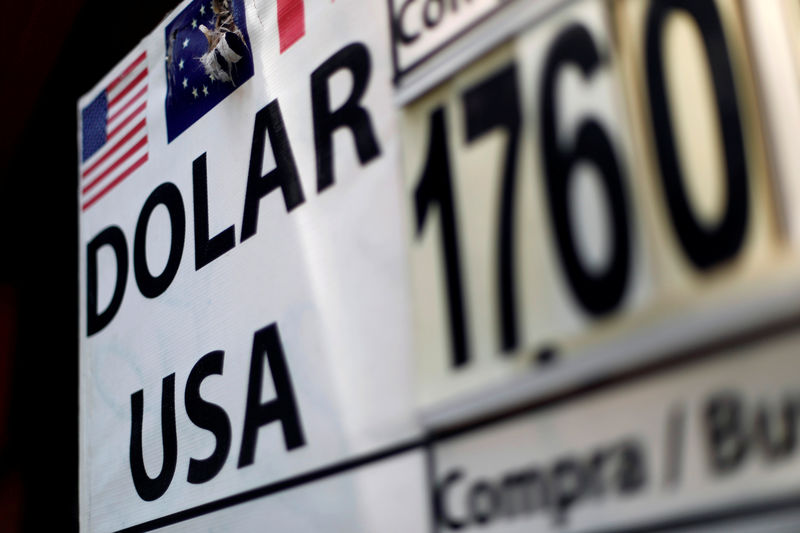By Saqib Iqbal Ahmed
NEW YORK (Reuters) - The striking calm in foreign exchange markets in recent months has led some U.S. multinational companies to scale back on guarding against currency gyrations, potentially leaving them vulnerable if volatility rebounds from near five-year lows.
Muted price moves across all asset classes, relatively benign economic data and a lack of big divergence in monetary policies around the globe have crushed currency turbulence as measured by the Deutsche Bank (DE:DBKGn) FX Volatility Index.
"If you look at periods of distress like the financial crises, the internet bust, the Greek debt crises or Brexit, those are always times when banks see a rapid pickup in hedging activity by their clients," said Mark Wendling, senior managing partner at Cincinnati, Ohio-based Bannockburn Global Forex LLC.
"With the lower volatility that we have seen in FX recently, some customers do get lulled to sleep and hedging activity drops," he said.
Companies that generate a large part of their sales overseas use strategies including forwards and options to guard against currency moves.
Low FX volatility, which makes for relatively cheaper options prices, and increased one-off demand for hedges due to a substantial pickup in dealmaking this year, should have boosted corporate hedging activity, currency strategists said.
Instead, FX corporate hedging flow from U.S. multinationals has been notably lighter than expected, said Andrew Scott, head of flow strategy & solutions at Societe Generale (PA:SOGN) in New York.
"For those hedging incoming non-dollar revenue streams, one plausible argument is perhaps the fact that no one actually quite believes that this dollar strength is sustainable," said Scott.
The dollar rose 6.2% on a trade-weighted basis in the first quarter compared to a year ago, its strongest quarterly performance since the fourth quarter of 2015, according to Federal Reserve Economic Data.
A rallying dollar is usually a negative for U.S. multinational companies, whose foreign currency revenues are worth less when the dollar is stronger.
While some companies have well-defined systematic approaches to FX hedging, others employ substantial discretion, analysts said.
Typically companies have preset hedge ratios but still have some room to maneuver within those ranges, Chuck Brobst, managing director at OANDA Treasury & Analytics in Chicago, said.
"Their strategy might require them to hedge between 60% and 80% of next year's foreign sales. Within that range, they have discretion of how much to hedge, so during periods of low volatility in currency markets, they act with less urgency, and remain less hedged," he said.
"At the margin, when volatility is low, more corporates are prone to take a directional view and wait to see which way the market breaks," he said.
Hedging activity has stalled over the last few months, with clients unwilling to take a bet on currency movements due to uncertainty about how long-running political conflicts will shake out, according to a trader with the foreign exchange group of a major bank who did not wish to be identified because of a lack of clearance to speak to the media.
The U.S.-China trade tiff, uncertainty about the outcome of Britain's efforts to leave the European Union and the potential impact on oil prices from a political crises in Venezuela are keeping clients on the sidelines, the trader said.
(Graphic: Foreign exchange volatility - https://tmsnrt.rs/2DFGyTJ)
However, volatility can return fast. This week saw an uptick in market gyrations driven by worries that Washington and Beijing could fail to reach a trade deal.
While interest in FX hedging has risen in general as companies grow and do more international business, there is room for activity to pick up once FX markets get choppier, said Amanda Breslin, head of Chatham Financial’s corporate treasury advisory group, in Denver, Colorado, that counts Fortune 100 companies among its clients.
"There's usually a little bit of a time lag from the time volatility spikes to the time corporates are actually feeling it flow through to their financials, getting heightened sensitivity from their board and then having a much shorter time frame to implement a solution or at least a go-forward risk reduction program," said Breslin.
That delay in actually putting hedges in place could mean increased volatility in corporate results, analysts said.
LOW VOL, NOT LOW RISK
"Currencies can trend and still have low FX volatility," said Amo Sahota, director at foreign exchange risk management consultancy Klarity FX in San Francisco.
"You see the low volatility and think I am not going to do anything about it, but it's like death by a thousand cuts," he said.
Steady foreign currency moves in one direction can still work against a company in times of low volatility, with the potential to impact results significantly.
Google parent Alphabet (NASDAQ:GOOGL) Inc, which does hedge its FX risk, said currency moves were partly to blame for slower revenue growth in the first quarter and expects FX moves to dent revenues again in the second quarter.

North American companies reported $20.84 billion in negative currency impacts in the fourth quarter of 2018, the most since the since the fourth quarter of 2015, according to corporate treasury and cash management solution provider Kyriba.